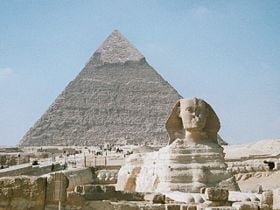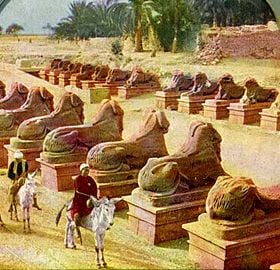Sphinx
A sphinx, perhaps one of the most recognizable mythological icons on the planet, has had a long history of secrecy and intrigue. Originally of Old Kingdom Egypt, the sphinx as a mythical creature carried on to Ancient Greece and still to this day fascinates many people.
Description
A sphnix varries in physical features, but is almost always a conglomerate of two or more animals. In ancient Egypt there are three distinct types of sphinx: The Androsphinx, with the body of a lion and head of person; a Criosphinx, body of a lion with the head of ram; and Hierocosphinx, that had a body of a lion with a head of a falcon or hawk. In Greek mythology there is less variation of the sphinx; a winged lion with a woman's head, or she was a woman with the paws, claws and breasts of a lion, a serpent's tail and eagle wings.
Egyptian sphinx
The sphinxes of ancient Egypt were regarded as iconic images. Usually, the Sphinxes appeared as giant statues with the faces of pharoahs and almost always were regarded as protectorares of temples or certain areas. To what extent the sphinx played a role in anicent Egyptian mythology is an issue of debate. While the sphinx is not the only combination of animal and man to emerge in the religious art of the time, it may be one of the first, pre-dating all other anthropromorphic images of animal dieties. The most famous and largest of sphinxes, Seshepus, the [Great Sphinx of Giza]] was originally dated to around the 4th century, but recent developments have raised the possibility that the sphinx might go back all the way to before the Old Kingdom.

The Great Sphinx was believed to stand as a guardian of the Giza Plateau, where it faces the rising sun. It was the focus of solar worship in the Old Kingdom, centered in the adjoining temples built around the time of its probable construction. Its animal form, the lion, has long been a symbol associated with the sun in ancient Near Eastern civilizations. Images depicting the Egyptian king in the form of a lion smiting his enemies appear as far back as the Early Dynastic Period of Egypt. The sphinx of Giza is an ancient iconic mythical creature usually comprised of a recumbent lion — animal with sacred solar associations — with a human head, usually that of a pharaoh, probably that of Khafre. [1]
During the New Kingdom, the Sphinx became more specifically associated with the god Hor-em-akhet (Greek Harmachis) or Horus at the Horizon, which represented the Pharaoh in his role as the Shesep ankh of Atum (living image of Atum). A temple was built to the northeast of the Sphinx by King Amenhotep II, nearly a thousand years after its construction, dedicated to the cult of Horemakhet.
Seen as guardians in the egyptian statuary, sphinxes are depicted in one of these three forms:
The largest and most famous is Sesheps, the Great Sphinx of Giza, sited on the Giza Plateau on the west bank of the Nile River, facing due east, with a small temple between its paws. The face of the Great Sphinx is believed to be the head of the pharaoh Khafra (often known by the Greek version of his name, Chephren) or possibly that of his brother, the Pharaoh Djedefra, which would date its construction from the fourth dynasty (2723 B.C.E.–2563 B.C.E.). However, there are some alternative theories that re-date the Sphinx to the pre-Old Kingdom – and, according to one hypothesis, to prehistoric times. Other famous Egyptian sphinxes include the alabaster sphinx of Memphis, currently localizated within the open-air museum at that site; and the ram-headed sphinxes (in Greek, criosphinxes) representing the god Amon, in Thebes, of which there were originally some nine hundred. What name or names the builders gave to the statues is unknown. The inscription on a stele in the Great Sphinx dates it from one thousand years after the carving of the Sphinx, and gives three names of the sun: Kheperi - Re - Atum. The Arabic name of the Great Sphinx, Abu al-Hôl, translates as "Father of Terror". The Greek name "Sphinx" was applied to it in the Antiquity. But it has the head of a man, not of a woman.
Greek sphinx
While it is more than likely that the Greeks accquired the idea of the sphinx through cultural diffusion, they nonetheless incorporated it to a larger degree into their written mythology and gave it its name (a potential combination of the Greek verb σφινγω — sphingo, meaning "to strangle" and the name Φιξ — Phix.
There was a single Sphinx in Greek mythology, a unique demon of destruction and bad luck, according to Hesiod a daughter of Echidna and of Orthrus or, according to others, of Typhon and Echidna — all of these chthonic figures. She was represented in vase-painting and bas-reliefs most often seated upright rather than recumbent, as Hera or Ares sent the Sphinx from her Ethiopian homeland (the Greeks remembered the Sphinx's foreign origin) to Thebes, where she gaurded the entrance to the city, asking all those who passed her famous riddle "Which creature in the morning goes on four feet, at noon on two, and in the evening upon three?" All those who answered wrong were killed, and it was not until Oedipus Rex came along and solved the riddle that the besieged city was liberated, making Oedipus King and setting the background for his mythical fall from grace (the answer to the riddle is man; a baby crawls when young, walks on two legs as an adult, and uses a cane in old age). [2]
The word "sphinx" comes from the Greek Σφινξ — Sphinx, apparently from the verb This may be her proper name, but The Penguin Dictionary of Classical Mythology states that her given name was Oedipus solved the riddle: man — he crawls on all fours as a baby, then walks on two feet as an adult, and walks with a cane in old age. Bested at last, the Sphinx then threw herself from her high rock and died. An alternative version tells that she devoured herself. The exact riddle asked by the Sphinx was not specified by early tellers of the story and was not standardized as the one given above until much later in Greek history. Thus Oedipus can be recognized as a liminal or "threshold" figure, helping effect the transition between the old religious practices, represented by the Sphinx, and new, Olympian ones.
Similar creatures
Not all human-headed animals of antiquity are sphinxes. In ancient Assyria, for example, bas-reliefs of bulls with the crowned bearded heads of kings guarded the entrances to temples. In the classical Olympian mythology of Greece, all the deities had human form, though they could assume their animal natures as well. All the creatures of Greek myth that combine human and animal form are survivals of the pre-Olympian religion: centaurs, Typhon, Medusa, Lamia. In Hindu tradition, one of the Avatars of Vishnu was the Narasimha which means 'man-lion'. The Avatar had a human body and the head of a lion.
Mannerist Sphinx
The revived Mannerist Sphinx of the 16th century is sometimes thought of as the French Sphinx. Her lovely coiffed head is erect and she has the pretty bust of a young woman. Often she wears ear drops and pearls. Her body is naturalistically rendered as a recumbent lion. Such Sphinxes were revived when the grottesche or "grotesque" decorations of the unearthed "Golden House" (Domus Aurea) of Nero were brought to light in late 15th century Rome, and she was incorporated into the classical vocabulary of arabesque designs that was spread throughout Europe in engravings during the 16th and 17th centuries. Her first appearances in French art are in the School of Fontainebleau in the 1520s and 30s; her last appearances are in the Late Baroque style of the French Régence (1715–1723).
Notes
- ↑ Winston, Allen 1999-2003["The Great Sphinx of Giza: An Introduction"] Retrieved January 23, 2007
- ↑ Hamilton, Edith. "Mythology" Little Brown: New York, 1942
External links
- [[1]] - The Classics Pages: Oedipus & the Sphinx
- An academic article arguing the case for water erosion evidence
- Egypt—The Lost Civilization Theory
- Satellite images of Great Sphinx of Giza at WikiMapia = Google maps + wiki
- The Sphinx's Nose
- Sphinx photo gallery
- Al Maqrizi's account in Arabic
Credits
New World Encyclopedia writers and editors rewrote and completed the Wikipedia article in accordance with New World Encyclopedia standards. This article abides by terms of the Creative Commons CC-by-sa 3.0 License (CC-by-sa), which may be used and disseminated with proper attribution. Credit is due under the terms of this license that can reference both the New World Encyclopedia contributors and the selfless volunteer contributors of the Wikimedia Foundation. To cite this article click here for a list of acceptable citing formats.The history of earlier contributions by wikipedians is accessible to researchers here:
The history of this article since it was imported to New World Encyclopedia:
Note: Some restrictions may apply to use of individual images which are separately licensed.

